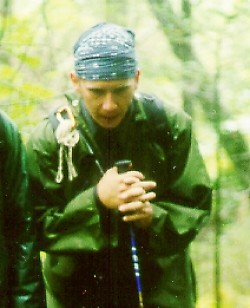Stephen N. Warren

B.Sc. (Honours) Thesis
40Ar/39Ar LASER-PROBE STUDY OF K-FELDSPARS FROM THE NEW ROSS AREA OF THE SOUTH MOUNTAIN BATHOLITH, NOVA SCOTIA
(PDF - 4 Mb)
The peraluminous South Mountain Batholith (SMB) intruded the metasedimentary rocks of the Meguma Supergroup in the Late Devonian.
Mineralization of metals in pegmatite, greisen, and vein deposits are found with K-feldspar within the New Ross Area of the SMB. This 40Ar/39Ar study utilizes the laser-probe method on fragmented K-feldspar grains. Analyses are performed on four K-feldspar samples; two from Long Lake (greisen and pegmatite), one from Walker Moly (pegmatite), and one from Millet Brook (vein). Fragments of feldspar from these samples were completely outgassed by a Nd-YAG laser and the results were compared with previously obtained age spectra from the 40Ar/39Ar step-heating analysis of Long Lake pegmatite, Walker Moly pegmatite, and Millet Brook vein K-feldspars. Rims of the K-feldspar were separated from cores and analyzed for age variability in all samples except for those from Millet Brook. For the Long Lake greisen, a mean apparent age of 260.4 2.8 Ma was calculated with the laser-probe with no rim/core age correlation.
This low age was suggested from previous studies. No age spectrum from previous studies was available for this sample. The Walker Moly pegmatite had a laser-probe calculated mean apparent age of 349.9 3.2 Ma with no age variations based on rim/core data. The laser analysis of the Long Lake pegmatite yielded the largest scatter of fragment ages with a mean age of 319.6 3.0 Ma. The corresponding age spectrum for this sample is the most discordant of all analyzed samples.
This reflects a large degree of variability in the distribution of radiogenic Ar within the K-feldspar. Variation in the ages between different grains of feldspar from the same sample is also assumed. The mean apparent age determined by laser analysis for the Millet Brook vein sample was calculated to be 355.4 3.5 Ma. The low scatter in the plot of fragment ages reflected the low range of ages on the age spectrum. The exsolution lamellae, development of microcline, and degree of alteration were noted in each sample with thin section investigation. These features were observed in order to determine how they related to the obtained ages and age variations. The laser-probe and step-heating determined ages were lower that the deposit ages (which are around the age of SMB emplacement). The 40Ar/39Ar ages determined in this study suggest that either there were open system conditions for 10-20 Ma after SMB emplacement or the K-feldspars had been completely reset at around 350-360 Ma. Most likely, there has been some interplay of slow K-feldspar cooling, prolonged open system conditions, and partial resetting during the geological history. The degree to which the mineralogical features of these samples affect the obtained 40Ar/39Ar dates should be considered further if future studies are to be conducted.
Keywords:
Pages: 56
Supervisor: Peter Reynolds



